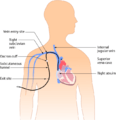Central venous catheter facts for kids
A central venous catheter (CVC), often called a "central line", is a special tube doctors put into a large vein. These veins are usually in the neck, chest, or groin. It helps doctors give medicines and fluids directly into the patient's bloodstream. It also helps them watch how well a patient's heart and blood flow are working.
Contents
What is a Central Line?
A central line is a thin, flexible tube. It is placed into a large vein. This allows doctors and nurses to give important treatments. It's different from a regular IV line. Regular IVs go into smaller veins, usually in the arm. Central lines go into much larger veins.
Why Do Doctors Use Central Lines?
Doctors use central lines for several important reasons:
- Giving Medicine: Some strong medicines, like those for cancer or serious infections, need to go into large veins. This helps the medicine work better and protects smaller veins.
- Fluids and Nutrition: Patients who can't eat or drink might get all their nutrition and fluids through a central line.
- Blood Tests: It's easier to take many blood samples from a central line. This avoids needing to poke the patient with a needle many times.
- Monitoring: Doctors can measure important things like blood pressure inside the veins. This helps them understand how sick a patient is and how to help them.
Where Are Central Lines Placed?
Central lines are usually put into one of three main veins:
- Neck: The jugular vein in the neck.
- Chest: The subclavian vein under the collarbone.
- Groin: The femoral vein in the upper leg.
The doctor chooses the best spot based on the patient's needs.
How is a Central Line Put In?
Putting in a central line is a medical procedure. A doctor or trained nurse does it.
- First, the area is cleaned very well to prevent infection.
- Then, the doctor uses medicine to numb the skin. This makes the area feel sleepy.
- They use a small needle to find the vein.
- A guide wire is then put through the needle into the vein.
- The central line tube slides over this wire and into the vein.
- Once the line is in place, the doctor removes the wire.
- The line is secured to the skin with a stitch or special tape. This keeps it from moving.
- An X-ray is often taken to make sure the line is in the correct spot.
Types of Central Lines
There are different kinds of central lines, depending on how long they are needed:
- Short-term lines: These are for a few days or weeks. They are often used in the hospital.
- Tunneled lines: These are for longer use, sometimes months or years. Part of the tube goes under the skin before entering the vein. This helps prevent infection.
- Implanted ports: These are placed completely under the skin. They have a small chamber that doctors can access with a special needle. They are good for very long-term use.
Caring for a Central Line
Central lines need careful attention to prevent problems.
- The area around the line must be kept very clean.
- Nurses regularly change the dressing over the line.
- The line is flushed with a special liquid to keep it from getting blocked.
- Patients and their families are taught how to care for the line at home if needed.
Possible Challenges
While central lines are very helpful, there can be some challenges:
- Infection: This is the most common problem. Keeping the line clean is very important.
- Blockage: The line can sometimes get blocked. Special medicines can often clear it.
- Movement: The line can sometimes move out of place.
Doctors and nurses watch carefully for any of these issues.
Images for kids
See also
 In Spanish: Catéter venoso central para niños
In Spanish: Catéter venoso central para niños









